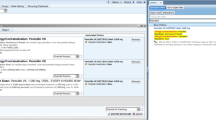Abstract
This study examines the feasibility of using automated computer data versus written medical record data to identify patients receiving guideline concordant treatment for schizophrenia. Central elements of care derived from published practice guidelines for schizophrenia were examined for a convenience sample of 28 patients who received acute inpatient treatment. The results showed that automated data were superior to medical record data for identifying some elements of guideline-concordant treatment. Not only were the elements of care examined in this study clinically significant and within the current capabilities of the existing computer information system, but they are also likely related to patient outcomes. Implications for clinical care, future research, and health care quality improvement efforts are discussed.
Similar content being viewed by others
REFERENCES
Gates, P.E., Think globally, act locally: An approach to implementation of clinical practice guidelines. J. Qual. Improvement 21:71–84, 1995.
Halpern, J., The measurement of quality of care in the Veterans Health Administration. Med Care 34:MS55–MS68, 1996.
Lobach, D.F., and Hammond, W.E., Computerized decision support based on a clinical practice guideline improves compliance with care standards. Am. J. Med. 102:89–98, 1997.
Agency for Health Care Policy and Research: Using Clinical Practice Guidelines To Evaluate Quality of Care: Volume 1/Issue, AHCPR #95-0045, 1995
Wells, K.B., Rogers, W.H., Davis, L.M., et al., Quality of care for hospitalized depressed elderly patients before and after implementation of the Medicare prospective payment system. Am. J. Psychiatry 150:1799–1805, 1993.
Kahn, K.L., Rogers, W.H., Rubenstein L.V., et al., Measuring quality of care with explicit process criteria before and after implementation of the DRG-based prospective payment system. JAMA 264:1969–1973, 1990.
Rubenstein, L.V., Kahn, K.L., Reinisch, E.J., et al., Changes in quality of care for five diseases measured by implicit review, 1981 to 1986. JAMA 264:1974–1979, 1990.
Samsa, G.P., Hanlon, J.T., Schmader, K.E., et al., A summated score for the medication appropriateness index: Development and assessment of clinimetric properties including content validity. J. Clin. Epidemiol. 47:891–896, 1994.
Hartz, A.J., Sigmann, P., Guse, C., and Hagen, T.C., The value of the uniform clinical data set system (UCDSS) in a hospital setting. Jt. Comm. J. Q. Improv. 20:140–151, 1994.
McGlynn, E.A., and Asch, S.M. Developing a clinical performance measure. Am. J. Prev. Med. 14(Suppl):14–21, 1998.
Eddy, D.M., Performance measurement: Problems and solutions. Health Aff. 17:7–25, 1998.
Iezzoni, L.I., Assessing quality using administrative data. Ann. Intern. Med. 127:666–674, 1997.
Grover, F.L., Hammermeister, K.E., Shroyer, A.L.W., Quality initiatives and the power of the database: What they are and how they run. Soc. Thor. Surg. 60:1514–1521, 1995.
Wray, N.P., Ashton, D.H., Kuykendall, D.H., and Hollingsworth, J.C., Using administrative databases to evaluate the quality of medical care: A conceptual framework. Soc. Sci. Med. 40:1707–1715, 1995.
Dresser, M.V.B., Feingold, L., Rosenkrantz, S.L., and Coltin, K.L., Clinical quality measurement: Comparing chart review and automated methodologies. Med. Care 35:539–552, 1997.
Terreros, D.A., Robinson, V.J., and Hodson, W.L., Is real-time quality asessment of health care an achievable goal? Ann. Clin. Lab. Sci. 24:96–99, 1994.
Stair, T.O., Reduction of redundant laboratory orders by access to computerized patient records. J. Emerg. Med. 16:895–897, 1998.
Baldessarini, R.J., Katz, B., and Cotton, P., Dissimilar dosing with high-potency and low-potency neuroleptics. Am. J. Psychiatry 141:748–752, 1984.
Beckmann, H., and Laux, G., Guidelines for the dosage of antipsychotic drugs. Acta Psychiatr. Scand. [Suppl]82:63–66, 1990.
Lehman, A.F., and Steinwachs, D.M., Co-Investigators of the PORT Project: At issue: Translating research into practice: The schizophrenia patient outcomes research team (PORT) treatment recommendations. Schizophr. Bull. 24:1–10, 1998.
American Psychiatric Association: American Psychiatric Association: Practice guideline for the treatment of patients with schizophrenia. Am. J. Psychiatry 154:1–63, 1997.
Frances, A., Docherty, J.P., and Kahn, D.A., The expert concensus guideline series: Treatment of schizophrenia. J. Clin. Psychiatry 57:3–58, 1996.
Spitzer, R.L., and Williams, J.B.W., User's guide for the Structured Clinical Interview for DSM-III-R, American Psychiatric Press, Washington, D.C., 1990.
Johnson, R.E., and McFarland, B.H., Antipsychotic drug exposure in a health maintenance organization. Med. Care 31:432–444, 1993.
National Committee for Quality Assurance, A Roadmap for Information Systems: Evolving Systems to Support Performance Measurement, HEDIS 3.0/1998, Vol. 4, Washington: NCQA, 1997.
Young, A.S., Sullivan, G., Burnam, M.A., and Brook, R.H., Measuring the quality of outpatient treatment for schizophrenia. Arch. Gen. Psychiatry 55:611–617, 1998.
Lehman, A.F., and Steinwachs, D.M., Survey Co-Investigators of the PORT Project: Patterns of usual care for schizophrenia: Initial results from the schizophrenia patient outcomes research team (PORT) client survey. Schizophr Bull. 24:11–20, 1998.
Owen, R.R., Thrush, C.R.N., Kirchner, J.E., Fischer, E.P., and Booth, B.M., Performance measurement for schizophrenia: Adherence to guideline recommendations for antipsychotic dose, Manuscript submitted for publication.
Stein, L.I., and Test, M.A., Alternative to mental hospital treatment: I. Conceptual model, treatment program and clinical evaluation. Arch. Gen. Psychiatry 37:392–397, 1980.
Kizer, K.W., Introduction and executive summary. VHA field reorganization—Report to Congress, title 38 U.S.C. 510(b), in Veterans Health Administration (VHA) (ed): Vision for Change—A Plan to Restructure the Veterans Health Administration. Veterans Health Administration, Washington, DC, 1995.
Author information
Authors and Affiliations
Rights and permissions
About this article
Cite this article
Hudson, T.J., Owen, R.R., Lancaster, A.E. et al. The Feasibility of Using Automated Data to Assess Guideline-Concordant Care for Schizophrenia. Journal of Medical Systems 23, 299–307 (1999). https://doi.org/10.1023/A:1020526327467
Issue Date:
DOI: https://doi.org/10.1023/A:1020526327467




